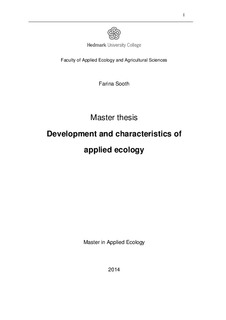| dc.description.abstract | The science of applied ecology is lacking a general theory and a commonly acknowledged definition. Additionally, information about the development of applied ecology over the past years, the relation to other disciplines and the importance of applied ecology in different continents are scarce. This is problematic because applied ecology is confronted with growing problems and the society demands more and more that it fulfils its promise of solving practical problems related to the environment. In the past applied ecology regularly failed to keep this promise and is faced with the future challenge of eliminating this problem.
Based on communication theory I assume that for a fruitful discussion about the future of applied ecology, the development and the understanding of ecology have to be clarified first to avoid to talk at cross.
Therefore, I conducted different qualitative and quantitative content analyses based on material from books and papers dealing with the subject of applied ecology or related disciplines to find out how applied ecology developed over time and what is understood under the term applied ecology.
I found out that applied ecology is a young and interdisciplinary oriented science. Its origin lays in the science of ecology and since the 1960s applied ecology developed from a discipline focussed on productivity and utilisation over conservation related topics to a stronger focus on social aspects today. Especially during the last 20 years the science field grew in North America and Europe.
Applied ecology wants to find solutions for real-world problems that can be of long- or short term dimension. It is concerned with ecological, economical and social problems that are connected to each other. The overall goal is to achieve harmony between humans and the environment. To do so, it wants to increase the understanding of the subject and then find solutions based in the information gained. For the implementation of the solution management plays an important role. However, people engaged in applied ecology seem to disagree about how strong the relation of applied ecology to management is and what exactly applied ecology should do to implement proposed solutions. My study shows that there is a c ommon pattern underlying applied ecology, but it also shows where ambiguities are that should be discussed and clarified in the future. It can be also used to give discussions about the challenges of applied ecology a common knowledge foundation. | nb_NO |
